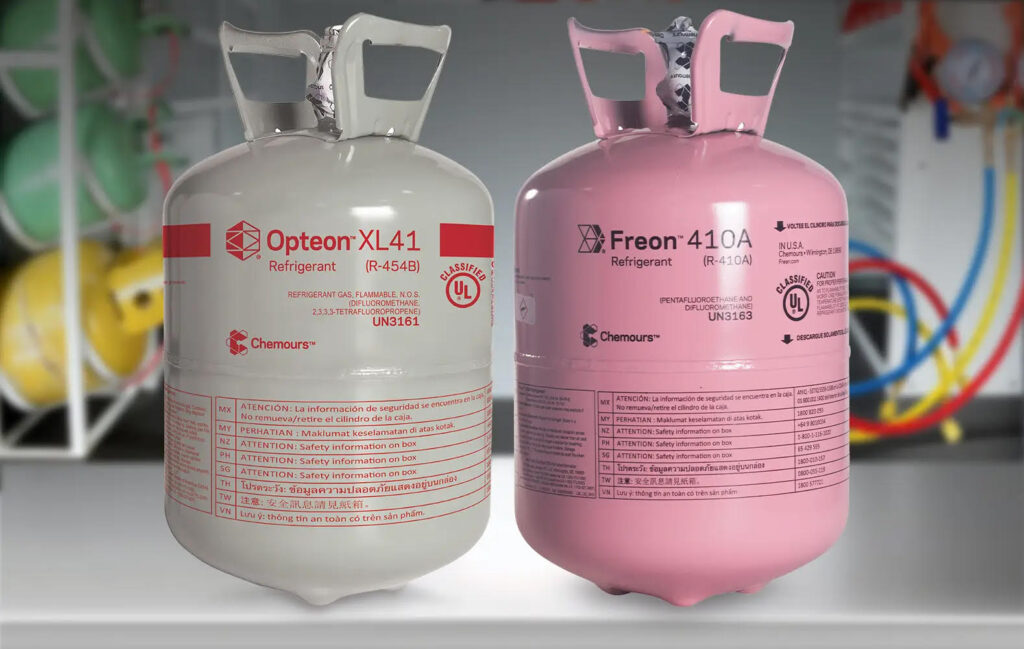In the world of heating and cooling equipment, change is constant. One of the most significant changes on the horizon is the upcoming phase-out of the standard refrigerant.
These changes will directly impact customers like you, so it’s crucial to understand what these changes mean and how they will affect you. In this guide, we’ll outline the timeline of the refrigerant phase-out, shed light on the new regulations, and provide actionable insights to help you navigate this transition smoothly.
Why the Refrigerant Changes?
The HVAC industry constantly evolves to meet environmental regulations and improve energy efficiency. As part of these efforts, new Environmental Protection Agency (EPA) regulations will soon lead to phasing out certain refrigerants currently used in HVAC systems.
Changes like this aren’t new. You may remember a similar regulation change when the R22 refrigerant was phased out a few years ago.
Changes like this are designed to reduce greenhouse gas emissions and promote more environmentally friendly alternatives. However, as with any regulation change, there is a ripple-down effect on the end customer. Let’s look at how this change will practically impact you.
R410 Refrigerant Phase-Out Timeline
R410 refrigerant has been widely used in HVAC equipment due to its high efficiency and low impact on ozone depletion. However, as part of ongoing efforts to combat climate change and reduce global warming potential (GWP), the EPA has determined that R410A should be phased out. This decision stems from the fact that R410A is a hydrofluorocarbon (HFC) with a relatively high GWP compared to other options.
Starting January 1, 2025, newly manufactured HVAC equipment may no longer use R410 refrigerant. The new industry standard refrigerant will be R454B. We’ll talk about that more in a minute.
First, let’s look at the R410 phase-out timeline and what that means if you currently have equipment that uses R410.
How long will R410 be available?
The R410 refrigerant will continue to be produced until 2034, steadily decreasing to about 20% of today’s production quantities.
This means that you will be able to get R410 for your current system for the life of that system. Not only will you be able to get the refrigerant, but manufacturers will continue to produce replacement parts for R410 systems for the system’s life.
Equipment that uses R410 will no longer be manufactured after 2024. In preparation for this change, most manufacturers have already slowed production on R410 equipment as they retool for the new equipment requirements.
If you have a newer HVAC system, there’s no need to worry about getting the most life out of that system. If you have an older HVAC system, these refrigerant changes are an excellent reason to consider replacing your old equipment with a new system that takes R410 because of the cost implications of this refrigerant change on new equipment.
How will the cost of R410 be impacted?
As you would expect and as the laws of supply and demand dictate, as production winds down and the supply of R410 goes down, the price will go up.
We’ve seen the same happen with R22 refrigerant. As of this writing, recycled R22 is still readily available fourteen years after new equipment was no longer manufactured to use it (2010) and four years after new R22 production was stopped (2020).
Although R22 is available for old equipment that uses it, the price of R22 has risen significantly. We expect the same to happen with the R410 phase-out.
R454B: The New Refrigerant
The new refrigerant that complies with the latest EPA regulations and the replacement for R410 in the marketplace is R454B. It is designed to have lower global warming potential (GWP) while performing similarly to R410.
Although this change is designed for a long-term positive effect on the environment, some drawbacks impact the end user.
How R454B will impact equipment costs
Though R454B has a lower GWP, the refrigerant is slightly flammable. Because of this, equipment must now include additional safety components to counteract this feature, making equipment about 25% more expensive.
It’s normal for equipment prices to increase as efficiency increases. However, in the case of R454B, it’s no more efficient than R410 equipment. This means you will pay more for a new AC system without gaining any additional efficiency and the energy savings that it provides.
Planning for shortages and delays
If you need residential HVAC equipment, it’s less likely that you will experience a shortage or delay. However, these things can change quickly. However, if you’re a business owner and need commercial equipment, it’s critical that you plan ahead.
Commercial equipment typically requires extra lead time for manufacturing. When there’s a refrigerant change like this, you must plan ahead if you have older equipment to ensure you’re not stuck without the HVAC equipment you need.
You will save significantly on the cost of commercial equipment if you order new equipment now and take advantage of R410 units still being available.
How to make the most of this change in refrigerants
Before these new regulations go into effect on January 1, 2025, there is an upside for customers. You know the change is coming, and you can take advantage of current equipment prices before they increase 25% in the new year.
Since R410 refrigerant and replacement parts will be available for the life of the system, you can get the most energy-efficient equipment available at the best price. This is true for residential and commercial equipment.
Our skilled technicians at Environment Masters have helped customers navigate multiple refrigerant regulation changes in the last 50 years. We are happy to answer any questions and help you assess whether now is the most beneficial time to upgrade your system before regulations take effect.
Call us today for a free consultation. 601-365-0005

